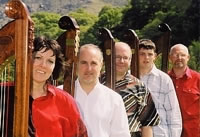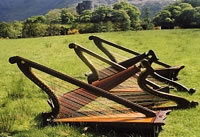Rhes Ganol - meaning 'the middle row’ takes its name from the uniqueness of the Welsh harp which has three rows of strings - Y Delyn Deires Gymreig - the Welsh Triple Harp. It is the first such choir of harps since the Llanover Welsh triple harp Choir which ceased before the outbreak of the First World War. Established in 2000, Rhes Ganol has gone from strength to strength and has been well received in concerts throughout Wales as well as having made numerous television appearances. They are now proud to present this, their first CD, Yn y Gwaed, the title of which comes from Nansi Richards, Telynores Maldwyn’s book Cwpwrdd Nansi: ‘Mae o yn y gwaed’ (‘It’s in the blood')

Members of Rhes Ganol (left to right) Rhiain Bebb, Huw Roberts, Robin Huw Bowen, Steffan Thomas, Wynn Thomas.
Triple harps

Introduction
For many years in the history of Wales, the sound of the triple harp was familiar throughout our Country. But things change. By the time Nansi Richards Telynores Maidwyn’ passed away in 1979, there were only a few players of the Triple still around, and even they were heard all too infrequently.
A quarter of a century later, it is very pleasing to see signs of a revival. This CD is testimony to a new generation of harpists who have reinstated this unique old harp, recognising its strengths and superiority, which they nosy firmly declare to their fellow Welshmen and to the World. They may still be small in number, but their zeal and enthusiasm are a definite sign that something is afoot a new movement which will ensure, we hope, that this is no short-lived whim.
One of the most curious questions is, why did the Welsh hold on to the Triple long after every other country in Europe had totally turned their backs on it? Part of the answer, surely, is that the harp has played an important role in our tradition through the centuries, way back into the mists of time. The Welsh knew a good harp when they saw one!
Leavitig the Triple Harp merely to collect dust in a museum would have been a tragedy. It is heartening therefore at the beginning of the twenty-first century to see a group of people with enough vision to stop the decline. In a world where, note than ever, the mass-media push a more uniform culture in us all, thank goodness for a group who take such pride in their own heritage, and whit are determined to breathe new life into an old tradition.
ARFON GWILYM
The Welsh Triple Harp
Without doubt, the Triple is the nations harp, with its long neck, three rows of strings, and its own unique sound. It was first devised in Italy in the late Renaissance, and after spreading rapidly throughout Europe, it reached London, where the Welsh itinerant harpists rook to it eagerly. It was adapted to be played ott the left shoulder, in the Welsh style, and was developed into a high-headed, elegant harp by the Welsh makers.
By the middle of the 18th century, it had established itself firmly
in North Wales, and later became accepted and honoured in the South.
It won respect as the national instrument in the eisteddfodau, in festivals,
and in the inn, until the arrival of the pedal harp in the Victorian
era. It would have disappeared totally during the 20th century, but
for the vision of Nansi Richards, who ensured its survival through her
work
on its behalf. Thanks to Nansis enthusiasm, we can proudly declare
that the Triple is here to stay, and is gradually establishing itself
again
at the beginning of a new century.
Credits
Diolch
i: Gwyn a Siân.
Thanks to: Dave Pope; Martin: Alice, Rethnn, a Pat; Eleri
Turner; Bryan Blackmore; Alun Thomas; Arfon Gwilym: W.A.L.
Thomas; Y Tabernacl, Machynileth; Llew Gwyn, Y Bala.
Hen lun - J.C.Ibbetson, from Edward Jones, The Bardic Museum
(I802)
Cynhyrchwyd
gan Rhes Ganol
Recordiwyd yn Stiwdio Bos Llanerfyl, Gwanwyn 2004
Peiriannydd recordio a chymysgu - Gwyn Jones
Lluniau - Martin Roberts
Cynllun y clawr - Clements-Pope Creative
Meistrwyd gan Donal Whelan yn Hafod Mastering.